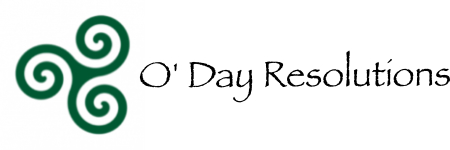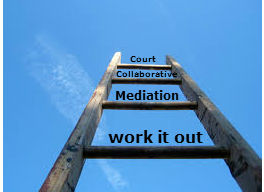I often explain to potential clients that the divorce process is somewhat like a ladder. The rungs on this ladder relate to the formality involved in the process.
The lowest rung would be the least formal and would correlate to the couple that is able to sit down at the kitchen table and work out the details of their divorce between themselves. In Florida they could then use the forms published by the Supreme Court (found here) and file the case with the court for final approval.
The next rung would correlate to a couple that may need more assistance, a couple that may want help in drafting the agreement or who cannot calmly work out the details without some professional assistance. In this case the couple can employ a mediator and, with the help of a skilled facilitator, work out the details of their divorce. This couple may decide to each retain legal representation to review the agreement after it is drafted or even to attend the mediation, but they determine early on that they will not litigate and do not need court intervention to reach an agreement.
The next rung would be occupied by a couple that struggles with a lot of issues such as developing a parenting plan, division of assets and ongoing support. They may need more formal structure and advice from separately retained counsel. The problem is that many couples skip an available rung and end up consulting litigation lawyers who advise them to begin the litigation process. This is a problem because the couple have now developed an adversarial posture by filing accusatory pleadings. The attorneys, because of their training and historic roles, often serve to increase the conflict through adversarial style of advocacy. Even as the attorneys work with the clients to resolve the case, they are constantly strategizing how the case will be tried in court if resolution fails. The parties have missed the “next rung” on the conflict resolution ladder — collaborative representation.
In the case of collaborative procedure, the parties would each retain legal counsel but the attorneys would be committed to working with the other professionals as a team to resolve the issues and minimize conflict. Being a trained collaborative attorney I can tell you there is a substantial difference when the parties have one financial expert whom they both trust, one mental health facilitator whom they both work with and two attorneys treating each other with respect and working towards a settlement without any motivation to prepare for possible trial. It truly is a “paradigm shift” for the attorneys. The collaborative process should be considered as the next rung on the dispute resolution ladder prior to any advice to consider litigation to resolve the case. Not every case may be appropriate for collaborative resolution, but too often this option is not even presented to the parties and they miss the opportunity to maintain control over their lives and the outcome of their divorce.
Collaborative Practice is also very different from the mediations that take place after many months of litigation and trial preparation. Often the parties in these cases have attended temporary hearings where they have become agitated and hostile. They have exchanged adversarial pleadings and answered extensive discovery requests. By the time they arrive in mediation each side has developed a hostile position for the negotiations. Often these cases start mediation with each side sitting in separate rooms with their attorneys and the mediator shuffling back and forth doing the “give and take” dance with the parties. There is a reason that many mediators often start these mediations with the advice that “if you both leave here unhappy then we have a good agreement” The parties have often invested so much in the conflict that their compromises are painful and hard fought. This too is different than the collaborative process where looking for creative solutions starts from day one.
If the collaborative process is unsuccessful, the parties can still climb the ladder to the last rung and resort to litigation. The couple will then turn their lives over the the straight-jacket structure of the laws passed in the state capitol and the formality of a court room. Evidence will be restricted by rules and the judge will make the ultimate decisions about how to resolve the conflict.

